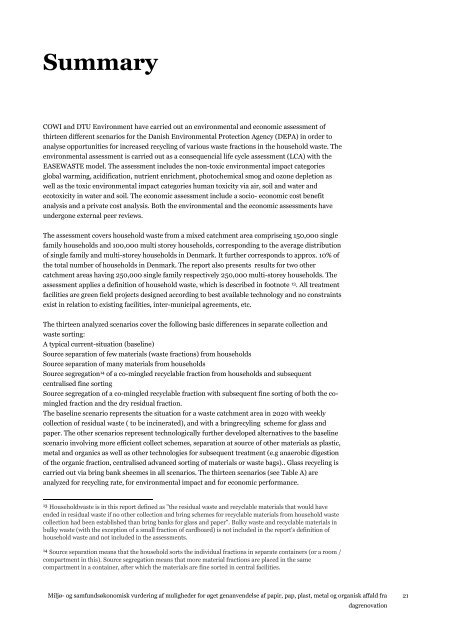Miljø- og samfundsøkonomisk vurdering af ... - Miljøstyrelsen
Miljø- og samfundsøkonomisk vurdering af ... - Miljøstyrelsen
Miljø- og samfundsøkonomisk vurdering af ... - Miljøstyrelsen
You also want an ePaper? Increase the reach of your titles
YUMPU automatically turns print PDFs into web optimized ePapers that Google loves.
Summary<br />
COWI and DTU Environment have carried out an environmental and economic assessment of<br />
thirteen different scenarios for the Danish Environmental Protection Agency (DEPA) in order to<br />
analyse opportunities for increased recycling of various waste fractions in the household waste. The<br />
environmental assessment is carried out as a consequencial life cycle assessment (LCA) with the<br />
EASEWASTE model. The assessment includes the non-toxic environmental impact categories<br />
global warming, acidification, nutrient enrichment, photochemical sm<strong>og</strong> and ozone depletion as<br />
well as the toxic environmental impact categories human toxicity via air, soil and water and<br />
ecotoxicity in water and soil. The economic assessment include a socio- economic cost benefit<br />
analysis and a private cost analysis. Both the environmental and the economic assessments have<br />
undergone external peer reviews.<br />
The assessment covers household waste from a mixed catchment area compriseing 150,000 single<br />
family households and 100,000 multi storey households, corresponding to the average distribution<br />
of single family and multi-storey households in Denmark. It further corresponds to approx. 10% of<br />
the total number of households in Denmark. The report also presents results for two other<br />
catchment areas having 250,000 single family respectively 250,000 multi-storey households. The<br />
assessment applies a definition of household waste, which is described in footnote 13 . All treatment<br />
facilities are green field projects designed according to best available technol<strong>og</strong>y and no constraints<br />
exist in relation to existing facilities, inter-municipal agreements, etc.<br />
The thirteen analyzed scenarios cover the following basic differences in separate collection and<br />
waste sorting:<br />
A typical current-situation (baseline)<br />
Source separation of few materials (waste fractions) from households<br />
Source separation of many materials from households<br />
Source segregation 14 of a co-mingled recyclable fraction from households and subsequent<br />
centralised fine sorting<br />
Source segregation of a co-mingled recyclable fraction with subsequent fine sorting of both the comingled<br />
fraction and the dry residual fraction.<br />
The baseline scenario represents the situation for a waste catchment area in 2020 with weekly<br />
collection of residual waste ( to be incinerated), and with a bringrecyling scheme for glass and<br />
paper. The other scenarios represent technol<strong>og</strong>ically further developed alternatives to the baseline<br />
scenario involving more efficient collect schemes, separation at source of other materials as plastic,<br />
metal and organics as well as other technol<strong>og</strong>ies for subsequent treatment (e.g anaerobic digestion<br />
of the organic fraction, centralised advanced sorting of materials or waste bags).. Glass recycling is<br />
carried out via bring bank sheemes in all scenarios. The thirteen scenarios (see Table A) are<br />
analyzed for recycling rate, for environmental impact and for economic performance.<br />
13<br />
Householdwaste is in this report defined as "the residual waste and recyclable materials that would have<br />
ended in residual waste if no other collection and bring schemes for recyclable materials from household waste<br />
collection had been established than bring banks for glass and paper". Bulky waste and recyclable materials in<br />
bulky waste (with the exception of a small fraction of cardboard) is not included in the report's definition of<br />
household waste and not included in the assessments.<br />
14<br />
Source separation means that the household sorts the individual fractions in separate containers (or a room /<br />
compartment in this). Source segregation means that more material fractions are placed in the same<br />
compartment in a container, <strong>af</strong>ter which the materials are fine sorted in central facilities.<br />
Miljø- <strong>og</strong> samfundsøkonomisk <strong>vurdering</strong> <strong>af</strong> muligheder for øget genanvendelse <strong>af</strong> papir, pap, plast, metal <strong>og</strong> organisk <strong>af</strong>fald fra<br />
dagrenovation<br />
21

















